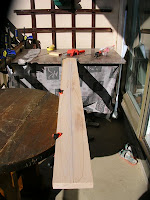 I found what I was looking for in my growing scrap pieces pile - a piece of rough-sawn yellow poplar that had been severly chiped on one edge, resulting in a bit of a natural point. I cut off a 5.5 inch wide piece, the actual width of the 2x6 board used in making the horse. The picture shows where I cut it from the stock and a rectangular through mortise I cut out to attach it to the anvil.
I found what I was looking for in my growing scrap pieces pile - a piece of rough-sawn yellow poplar that had been severly chiped on one edge, resulting in a bit of a natural point. I cut off a 5.5 inch wide piece, the actual width of the 2x6 board used in making the horse. The picture shows where I cut it from the stock and a rectangular through mortise I cut out to attach it to the anvil.I quickly realized that a scrap piece of disfigured maple (with a major knothole) I had been keeping would be the perfect piece to complete the anvil. It was just a slight bit more narrow than the slot I had cut in the horse so there was no chance of the anvil wiggling from side to side when pressed with the foot pedal. By cutting a through tenon that would fit in the poplar head piece, I'd be able to make a stronger anvil that would still be able to be disassembled. This would be my first attempt at cutting something like this, but with a few careful measurements I proceeded to cut out the maple stock with my regular cross-cut saw and ended up with a crude, but satisfactory tenon for this project. To finish off, I used a 1 1/4" spade drill bit to cut a hole for a hardwood dowel. This I ensured was a 1/4 inch lower than where the anvil head would rest so that I could custom fit a dowel and secure the head in place.


Measured tenon lines and final anvil
The hardwood dowel scrap I had lying around was flatten on one edge by clamping it to a vise and using the handy spokeshave. This way, when inserted in the hole it would press flat against the top of the poplar anvil head and hold it in place tightly. This took some trial and error to get right as I didn't want to over shave the dowel piece I had on hand. Everything worked out well and the head fits nice and tight. On the horse, I drilled 2 more hole positions for the 6inch carriage bolt used as the fulcrum so as to be able to move the vise closer or further away as the project demanded.


Flattened Dowel & Assembled Headpiece
Ultimately, I wanted to re-install the foot pedal system on the first edition, but fitting it with the maple piece required to much extra reshaping of the wood. So I just used the spade bit to drill another hole for the remaining bit of scrap dowel and that is used as a pedal. I could cut another through mortise in another scrap piece to use as a peddle and hold it in place on the bottom with a smaller piece of dowel, but I'm lazy and want to get back to paddle making.


My horse isn't going to win any prizes for looks, but this new edition folds down well for storage & transport and suits my current paddle making needs.
By the way, for anyone else who wants to build their own, I basically adapted my horse from the info gleamed on the following links:
• Richard Burton's plan
• Bob Smalser article at WoodCentral.com
• Tom Rettie's article at BloodandSawDust.com
• The photo intensive page at trod.org




















































